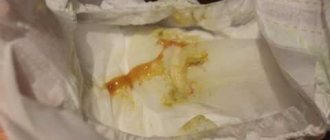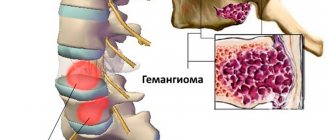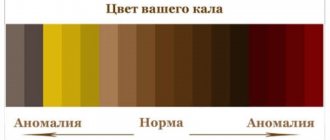Our feces have a very important function. In fact, the masses that come out of the human body are not so useless. Food, having passed through the gastrointestinal tract, is not just processed products; at the exit, their condition tells us about the state of affairs inside our body. It is the feces that primarily reflect changes in the functioning of many vital human organs. Therefore, it is necessary to regularly monitor the condition of your poop and check for signs that are not usually characteristic of poop, one of such signs being white lumps in the stool. However, if you are reading this article, then most likely you have noticed white spots in your stool or your child’s stool. In this article we will look into this issue and talk about the reasons that can cause the appearance of various kinds of grains, inclusions or lumps of white color in poop.
Where do white spots in stool come from and what could it be?
White specks in stool are not always a sign of a problem with your body or the presence of a disease. In order to more accurately determine the origin of foreign bodies, it is necessary to observe the feces for some time.
White spots in stool are of the following types:
- In the form of lumps or grains;
- In the form of threads, veins or worms.
They can also be divided into two groups based on origin:
- Food products, in this case, white grains are harmless and are not a cause for concern;
- Parasites;
- Disturbance of microflora and inflammatory processes in the intestines.
Below we will take a closer look at all types of white inclusions and find out what they can be.
Diet for diarrhea
Diet is one of the components of treatment. Since with any diarrhea there is irritation (and often severe inflammation) of the intestinal mucosa, food should be as gentle and easily digestible as possible. For diarrhea it is recommended:
- drink more (drinks at room temperature, warm), the preferred drinks are simple drinking water, water-salt mixtures, warm tea, weak jelly, astringent and enveloping herbal teas and infusions. Alcohol, milk, fruit juices, carbonated drinks should be avoided;
- do not eat if you have no appetite (this is a protective reaction of the body);
- When you have an appetite, you can start with secondary broths, oatmeal or rice porridge (in water), dried white bread, mashed potatoes, boiled lean meat (a little, pureed). Then you can try boiled and baked vegetables and fruits. Food should be semi-liquid, homogeneous, it should be taken often and little by little;
- Until stool is completely normalized (and preferably for some time after), fresh fruits and vegetables, as well as alcohol, fatty, spicy and fried foods should be avoided.
White lumps caused by food
This option for the appearance of grains is completely harmless, but sometimes it can tell you that you need to pay attention to your diet or the quality of the foods you eat. There may be cartilage from bones interspersed in the poop; perhaps you ate chicken and accidentally swallowed the cartilage. Cartilage can also get caught in sausages. You may have accidentally swallowed something, such as egg shells. If you are taking any medications, this could be it. Remember if you consumed any of the above or something similar, exclude such products from your diet and, if the situation does not change, then the matter is different.
Bile level disturbance
It is bile that gives stool its characteristic light brown color. Without this element, normal digestion of food is impossible. A decrease or increase in the level of bile in the stomach can occur due to a variety of diseases.
First of all, this is cholecystitis - inflammation of the gallbladder. It is this organ that produces concentrated bile and supplies it to the liver and gastrointestinal tract. With cholecystitis, the normal content of bile changes, which leads to incomplete digestion of part of the food.
Another reason for decreased bile levels is liver disease - cirrhosis and hepatitis. These diseases usually follow one from the other. That is, hepatitis first appears, characterized by inflammation of the liver, and if left untreated for a long time, it turns into cirrhosis. And in this state, liver cells not only degrade, but also completely die, reducing liver functions to zero. Naturally, in this state, it cannot pass bile through itself and regulate its level.
Cirrhosis is caused by alcohol abuse, and hepatitis is easily transmitted from person to person through touch and blood. For example, hepatitis A is called household hepatitis precisely because it can be contracted by using dirty dishes. And hepatitis B is transmitted only through poorly sterilized medical instruments. Additional signs of liver failure are abnormal bowel movements, pain in the right hypochondrium and stomach, nausea, and vomiting.
With cholecystitis, stones form and accumulate in the gallbladder. They impede the movement of bile through the ducts, sometimes blocking them completely.
White strings in stool as a sign of parasites
An unpleasant and at the same time dangerous manifestation of worms in feces is worms. If you notice them in your chair, then carefully examine the shape and size. Also pay attention to the systematic appearance of the threads, how often it happens, whether it happens every day, how long ago it appeared, whether there are other changes in your health, nausea, loss of appetite, or, conversely, discomfort in the abdomen. If the worms move, then you can say with 100% probability that you have worms. You should immediately consult a doctor to determine the extent of the infection. You shouldn’t just eat garlic or take pills, as many do. Since you need to know what type of parasites you are faced with, and also find out whether the new residents have caused harm to your body.
Some types of worms cannot reproduce in the human intestine, so when they reach sexual maturity they rush out to lay eggs near the anus. Thus, when feces pass through the intestines, worms get into them. It also happens when the worms come out not completely, but partially. As a rule, these are tapeworms, which are extremely dangerous and require hospital treatment.
If you have the slightest suspicion of parasites, immediately take the stool to the laboratory for analysis.
Watery diarrhea (“water diarrhea”)
Its causes can be both bacterial and viral infections. The most severe of them, of course, is cholera, but salmonellosis and acute intestinal infections of viral etiology are much more common. The small intestine is affected by pathogen toxins, this is accompanied by the release of large amounts of water and salts dissolved in it into the intestinal lumen (stool may resemble “rice water”), without adequate replenishment of electrolytes, fatal dehydration can occur. Requires hospitalization in a specialized hospital (intestinal infections department).
Self-diagnosis and treatment are unacceptable. Diarrhea due to intestinal infections may not always be accompanied by nausea, vomiting, abdominal pain and fever (in weakened patients, as well as in the terminal stages of cholera, body temperature may drop below normal); treatment directly depends on the type of causative agent of the disease, which is impossible to determine at home.
White streaks caused by intestinal disease
Another reason that can cause white lumps in feces is various types of inflammatory processes in the intestines, microflora disorders and infections, in some cases several factors are involved simultaneously.
Often the cause of white lumps in poop is a symbiosis of candidiasis and dysbiosis.
REFERENCE!!!
Candidiasis is a parasitic fungus that occurs not only in the intestines, but also in other parts of our body. In the women's ranks it is known as thrush.
Candidiasis forms a curdled mass on the intestinal walls, which ends up in feces. Together with dysbacteriosis, mucus appears on the stool along with white lumps.
If the white spots are caused by a fungus, then the following symptoms are observed:
- Pain in the rectum that has a pulling and aching character;
- Painful sensations when you want to poop;
- Sometimes blood may also be present;
- Burning and itching in the anal area;
- Redness and irritation in the form of peeling skin may appear around the anus.
It is worth noting that you should not self-medicate. It is better to consult a doctor to establish the most correct diagnosis, as well as to identify the cause of the disease. To make a diagnosis and prescribe the correct treatment, an examination is necessary.
Possible complications of diarrhea
- dehydration (even death): this is indirectly evidenced by such signs as dry lips, tongue, decreased turgor of the skin and eyeballs, severe thirst, rapid breathing, and rare urination;
- loss of salts by the body (occurs in combination with loss of fluid) can cause convulsions;
- exhaustion of the body, hypovitaminosis (with chronic diarrhea);
- intoxication (poisoning with bacterial or viral toxins);
- hemorrhoids, rectal prolapse, ulcerations and fissures.
What causes white lumps in children's stool?
Now let's talk about children. Basically, the reasons for various types of white spots in children are the same as in adults. The only thing is that there are minor differences between infants and, as a rule, they lie in the peculiarities of feeding. The newborn’s body is completely fragile and reacts differently to new food; when the body adapts to new foods, everything goes away. In all other cases of the appearance of white lumps in the stool of infants, the reasons are the same as described above. In any case, there is no need to wait for something and experiment with food; it is better to consult a doctor for help. Since if the reason is not at all in the diet, then the consequences can be serious. In children, diseases develop much faster and cause significant harm.
Don’t forget that you need to monitor the condition of your stool; as we have already said, you can identify the first signs of illness. Many changes in the body are primarily reflected in the digestive system, and poop is a kind of spy that carries important information.
Black diarrhea
The most serious reason that can cause black loose stools is esophageal, gastric or intestinal bleeding (for example, varicose veins of the esophagus, gastric or duodenal ulcers, tumors). When blood comes into contact with digestive enzymes, it turns black. Tar-like stool indicates fairly heavy bleeding. If it is localized in the stomach, sometimes coffee-ground vomiting occurs. Critical blood loss can occur quite quickly - the patient must be taken to a surgical hospital as soon as possible. Sometimes blackening of the stool is caused by taking certain medications (activated carbon, iron, bismuth, vitamin-mineral complexes).
Hypercalcemia
Toxins and undigested food elements are removed from the body with feces. These include calcium. It is taken as part of immune-strengthening therapy or as an additional substance for the muscles and bones of athletes.
Calcium is a solid and cannot be completely dissolved in the body. Therefore, it does not exit through the urinary system. He has only one way out - with feces. Calcium is white. In stool it appears as small white dots.
A large amount of calcium can result in frequent constipation, nausea, and even vomiting. Due to an overdose of calcium, a person feels constant weakness and general malaise.
Lactose intolerance
Lactose is a unique substance found only in dairy products. Its structure resembles sugar. But not all organisms can digest lactose. This is caused by the excellent composition of gastric juice. There are few such people, but they do exist. Due to the unique composition of their gastric juice, they cannot consume dairy products. Some people get diarrhea from them, some get flatulence, and some people get pieces of undigested lactose in their stool.
Treatment in this case is a long-term adaptation to a new diet designed to change and normalize gastric juice.










